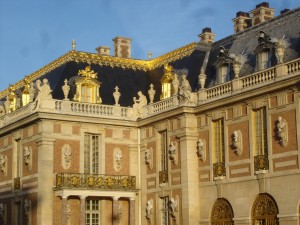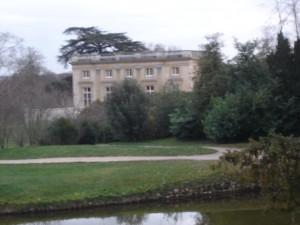From the Salon to the Scaffold
Notes to a program at Maverick Concerts for July 14th, 2012
Bastille Day
I prefer that which touches me to that which surprises me
The composer, François Couperin (1668-1733)
I prefer the bizarre to the insipid
The painter, Anne-Louis Girodet (1767-1824)
Nothing (happened)
The King Louis XVI, Journal entry for July 14, 1789
July 14th is the day we recognize as the boundary between the Old Regime and the new, republican world of France. But this revolution is only one manifestation of a large social movement traceable in all facets of society. Art, music, literature, city life, even food change throughout the 18th century in a metamorphosis of values and power.
HISTORY LESSON I
Louis XIV distrusted and disliked the nobility. His brother, cousins, and distant relatives all represented a greedy threat to his position of absolute power in France. Recent history taught him that a brother could not be trusted (his father Louis XII and uncle Gaston were always in crisis and competition). His frightful experience of the Fronde, a war in which the nobility wanted to wrestle power from the king, had him imprisoned in the Palais Royal while the streets of Paris became death traps for him and his supporters.
Louis XIV trusted the enterprising, upcoming middle class. These wealthy, entrepreneurs who figured out how to sail the new seas of commerce and industry garnered Louis’ respect and were, for the moment, uninterested in taking his power.

As he matured, Louis created a utopia of social and artistic delights for his nobles, robbing them of any political appetite or aspirations and filling them with courtly (frou-frou) values. Versailles became a most magnificent and unnatural gilded cage. Positions of decision and power went, one by one, to middle class brain trusts.
Both the nobility and the new bourgeoisie owed everything to the King and thus a perfectly balanced triangle was formed. At the two lower points, the bourgeoisie and nobility on either end looked up to the King for entitlement and advancement and looked at each other with jealousy and fear. Louis had the country in his control, in the palm of his hand. It was brilliant and explains his famous line, “the state is me.”
It was a fragile balance. It could not last. Louis XV famous line, “after me, the flood” understands the fragility of this social order. That order collapses in 1789. The middle class realizes that their wealth and canny working of the modern industrializing world is all they need to hold power. The king has become simply the leader of the entitled nobility, for whom they have little respect or patience. The nobles are mostly poverty stricken and both incapable and disdainful of real work. Louis XVI simply can’t grasp the change in power and align himself wisely to maintain his position.
OFF WITH THEIR HEADS.
SOME MUSIC (click here for Leclair’s Deuxieme Recreation: Chaconne 1737)
Music from the gilded cage court of Versailles is poetic, rarely dynamic. It presents us with a glimpse of the exquisite. All our passions are expressed in refined, tender, gentle ways. No large waves, no suggestion of great change, no rocking the boat on the canal as we might glide gently towards the setting sun, through the gardens and away from the marble and golden stone of the Chateau’s façade.
François Couperin, in any movement, takes us to a place in our heart, treats us to a gentle perfume and array of delightful colors, enlivened as one note or a sweet unexpected harmony turns a smile into a sigh, or allows a golden ray of sunshine to emerge from a cloudy sky. He moves us but never shocks us in this courtly world of fragile beauty. If the music of 1714 seems always slightly melancholy and if the contemporaneous paintings of Watteau barely hide an ever present sigh it is because, as Verlaine says in one of his poems looking back to these times, “they don’t believe their own happiness.”
Jean Marie Leclair incorporates elegance of courtly expression. But Leclair is an early matinee idol, a precursor of Paganini, an entrepreneur wishing to grab the imagination of a public made up of middle class music lovers who want to be wowed. There is exaggerated expression and surprises in harmony that might annoy Couperin’s perfectly ordered world but delight in the less exquisite life of the Parisian ticket buyer. Our flute sonata tonight does not shock as much as the violin works that Leclair used to astonish, but it does reside half way between the music room of Mme. de Maintenon and the public concert hall of the rising families of Paris.
The most dangerous character in this carefully balanced courtly world is the one who cannot control his or her passions. She is an object of frightful fascination and Medea’s personality and story have the attraction and appeal of a roadside disaster to which our eyes are drawn and our minds want to but cannot avoid. Clérambault in his cantata Medée examines the fire, passion and poison of the uncontrolled heart, its danger and its dynamism and appeal. Clérambault introduces us to Medea as she contemplates the upcoming wedding of Jason with his newfound princess and we listen to the tortured soul that vacillates between helpless love, abandonment and intense fury. Unsuccessful pleas to heaven and love for help are followed by answered incantations to hell and its demons for revenge. For all its brilliant vocal writing and exciting accompaniment, please keep that woman away from Versailles!
HISTORY LESSON II
Marriage in the 16th and 17th century was a contract between families that secured lands, money and power. Romance was not a consideration and effect on the heart was immaterial. The nobleman’s house was in the shape of a squared off U. The bottom of the U presented the entrance into the home, the public rooms in which both families represented by husband and wife, presented themselves as a unified corporation to the public. Each of the far off wings was the wife’s private apartments and the husband’s. Their intimate lives took place as far apart from each other as the building could allow.

The middle class copied the form of the noble building but redefined the purpose of the structure. The dining room was placed in front replacing the most formal salons. Here, husband and wife would meet for each meal with their children and enjoy the most intimate and loving times of the day. Husband and wife, at the end of each day walked into one side of the building to sleep together in their single bedroom. Family time and committed personal relationships were the stuff of middle class values. This was foreign to both Louis XIV and XV. But Louis XVI and Marie Antoinette as well as George III in England preferred these values and changed their lives to accommodate a new domestic happiness. In the Le Petit Trianon, Marie Antoinette’s private dwelling, the dining room is the central, magnificent living space.
Other than unleashed passion, CHANGE was the great fear of the nobility at Versailles. These people were born to entitlement from a distant past without a rational explanation for their good fortune. Any change could only mean separation from this socially elite position and so change is a nightmare. For the middle class, change means improvement. Each year, decade and generation seems to benefit from a changing city and world. Money and control increase as the vision of the world modulates. A dynamic society promises new and better tomorrows.
SOME MUSIC (click here for Trio in F: Presto of Johann Schobert 1760’s)
As the Parisian, music hungry audiences, emulating noble accomplishments, learned to sing and play, magazines for music appeared in town. Each week a series of pages were printed and sent out to subscribers who would find favorite songs from recent operas, overtures and sets of variations for keyboard, often with violin, and new songs on recent books or events. Both Les Liaisons Dangereuses and the translation of Goethe’s Werther were met with songs to be sung by young Parisians who were moved to tears, and in the case of the Goethe novel, to suicide!
Here the emotions are not restrained nor elegant but strong and sentimental. Instrumental music reflects the dynamic qualities of the rising middle class and rejects the static yet highly poetic nature of courtly art. Far from feeling this old music exquisite, the new audience heard it as insipid. Action, development, energy become the qualities that seize the imagination. It is the music of Devienne, one of the earliest composers at the revolutionary Paris Conservatory and the soul and spirit behind the flute as it entered into the 19th century. He and his colleagues begin their great migration from Couperin to Berlioz, from the touching to the bizarre, from the salon to the scaffold.




Leave a Reply